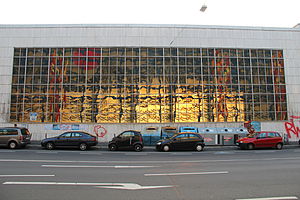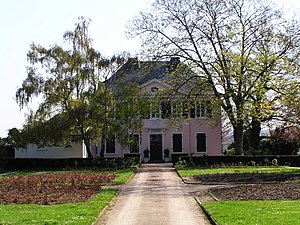City Museum Bonn

The Stadtmuseum Bonn ( spelling : StadtMuseum Bonn ) was founded in 1989 and is dedicated to the presentation of Bonn's urban and cultural history as well as the presentation and maintenance of the extensive collection. The museum rooms are currently located in a building erected in the 1970s at Franziskanerstraße 9, opposite the university building adjacent to Koblenzer Tor in downtown Bonn . The two floors used by the museum previously belonged to the sauna and cleaning wing of the now abandoned Viktoriabad . A further whereabouts in the premises is unclear.
history
In 1886, an association was founded in Bonn with the aim of creating a city history museum. Today's Bonner Heimat- und Geschichtsverein transferred its extensive collection to the city of Bonn in the mid-1950s, which resulted in close cooperation between the association and the city archive. In the anniversary year 1989 ("2000 years of Bonn"), the city council under Lord Mayor Bärbel Dieckmann passed the resolution to found the Bonn City Museum, although no suitable premises were available at the time. In the early years, only the small Ernst-Moritz-Arndt-Haus at Adenauerallee 79 could be made available to the newly founded museum . Small special exhibitions and cultural events have taken place and are still being held here. The founding director of the museum was the head of the city archives, Manfred van Rey . The opening of the actual showrooms for the permanent exhibition of the city museum (“From Roman times to today”) in the later allocated building on Franziskanerstraße took place on January 14, 1998 on 1000 square meters.
The museum, directed by Ingrid Bodsch , with almost 1,300 square meters of exhibition space, is visited by thousands of visitors every year, including many school classes. In addition to the maintenance of a permanent exhibition on the city's history and a memorial exhibition on the persecution of minorities in the time of National Socialism in Bonn in the lower area, around 90 events are organized annually. The whereabouts of the museum in the buildings on Franziskanerstraße is uncertain. In 2015 the city planned to sell the block known as “Viktoriakarree” (which also includes the museum property) to the private investor group Signa , who wanted to build a shopping mall there. Due to the lack of suitable alternative options, it was planned to split the museum exhibition: the memorial was to be relocated to an elevated office in the Bonn town hall , the permanent exhibition on the city's history in a small area of the Rheinisches Landesmuseum Bonn . After the redesign of the building block was canceled, at the suggestion of the chairman of the Friends' Association of the Bonn City Museum, Gisbert Knopp , a relocation of the exhibitions to the historic and, since 2010, unused, former swimming pool of the Viktoriabad is discussed. The swimming pool, the glass front of which was designed by Gottfried Böhm , has been a listed building since 2013.
Stocks
The complete collection of the Bonn City Museum contains over 10,000 individual items - including around 600 paintings, 1,900 graphics, 1,700 rare books and other antiquarian works, 1,500 arts and crafts exhibits, 200 sculptures, 250 pieces of furniture, historical clothing and uniforms. The largest part comes from donations and testamentary dispositions, which were mainly given in the second half of the 20th century with a view to founding a museum; a large part of these holdings relates to the 18th and 19th centuries. Curt Delander bequeathed his collection to the museum. The foundation was made up of the works of art from the foundation of the medical doctor and university professor Franz Obernier (1839–1888) - especially 19th century paintings from the Düsseldorf and Munich painting schools . Today there are also works by Marianne Pitzen , Karl Rudolf Sohn , Karl Ferdinand Sohn , Heinrich Wettig and Gustav Wunderwald .
The parts of the collection shown in the museum give an insight into the city's 2000-year history. In addition to an antique floor mosaic (, an originally-positioned on the cathedral square medieval court sign - - popularly referred to as "stone Wölfchen" the "Bonn Lion" are the city emblem ), baroque city views, a fully equipped grocery store from 1893, a hairdressing salon from 1900 as well as two salons of middle-class families from the turn of the century . In one of these rooms you can see the dining table of the Tenten entrepreneurial family from the early days of the company , which is covered with tableware from the former Bonn porcelain and earthenware factory Ludwig Wessel .
Andreas Emmel dinner service
Significant exhibits in the museum are nine extraordinary pieces of a silver dinner service that originally consisted of 314 pieces . The Electoral Councilor Paul Joseph Reichsfreiherr von Landsberg-Velen had commissioned this service for 36 people in 1792 from the goldsmith Andreas Emmel (1759-1828). Emmel, who trained under Johann Jakob Math in Vienna , created the service between 1792 and 1794. Inspired by Parisian, Strasbourg and Viennese models, it was kept in the Empire style , which was then in vogue . The individual pieces are decorated with acanthus leaves , laurel sticks , lions ' heads , rams' heads , pine cones and pearl sticks . Emmel used all metalworking techniques known at the time: driving , casting , punching , dotting, chasing and engraving . The individual pieces purchased with funds from a consortium of various institutions are three terrines , two four-armed girandoles and four candelabra .
memorial
The Bonn Memorial is also located in the premises of the City Museum . The persecution and murder of the Bonn victims of National Socialism is shown in several rooms with image and written documents as well as original exhibits. The exhibition presents research results on the arbitrariness of the dictatorship of the Third Reich and its effects on everyday life, as well as the opposition and resistance in Bonn. Thousands of forced laborers and prisoners of war who were deported to Bonn are also remembered. The association that supports the memorial is the association An der Synagoge e. V. The memorial also offers lectures, readings and discussions with contemporary witnesses.
See also
Web links
- City Museum. Website of the city of Bonn
- Schumann portal , a project of the city museum
- Information on the Bonn Memorial. In: schwarzaufweiss.de
Coordinates: 50 ° 44 ′ 4.7 " N , 7 ° 6 ′ 16.4" E
Individual evidence
- ↑ a b History of the Bonn City Museum. Website of the city of Bonn. March 8, 2013, accessed April 18, 2017.
- ^ Bonner Heimat- und Geschichtsverein: History. Website of the Bonner Heimat- und Geschichtsverein, accessed on April 18, 2017.
- ^ Stadtmuseum Bonn and Ernst-Moritz-Arndt-Haus: History. Website of the city of Bonn, accessed on April 18, 2017.
- ↑ Ernst Moritz Arndt House. Website of the city of Rheinbach, accessed on April 18, 2017.
- ↑ a b Bernward Althoff : Land in the Viktoriaviertel in Bonn: the city museum and the memorial are to be "outsourced". In: Kölner Stadt-Anzeiger . October 7, 2015, accessed April 18, 2017.
- ^ A b c d e Frank Vallender: The Bonn City Museum: Threatened Treasures. In: Bonner General-Anzeiger . August 31, 2015, accessed April 18, 2017.
- ^ A b Daniel Bartetzko, Karin Berkemann , Julius C. Reinsberg (eds.): Bonn: Museum with chlorine smell? In: Moderne-regional.de. April 12, 2016. Retrieved April 18, 2017.
- ↑ Ingrid Bodsch : Only »Events« as a visitor magnet? Cultural history museums as perceived by visitors. In: Beatrix Commandeur, Dorothee Dennert (Hrsg.): Event draws - content binds: Visitor orientation on new paths (= publications on culture and museum management ). transcript Verlag, Bielefeld 2004, ISBN 3-89942-253-8 , pp. 153–154, here: p. 153, doi : 10.14361 / 9783839402535-017 .
- ^ The Tenten room in the Bonn City Museum. Tenten Foundation website, accessed April 18, 2017.
- ^ A silver service from Andreas Emmel. Website of the Kulturstiftung der Länder , accessed on April 18, 2017.
- ↑ Visitor information. Bonn memorial. In: ns-gedenkstaetten.de, accessed on May 10, 2018.
- ↑ Memorial to the Bonn victims of National Socialism. Website of the city of Bonn, accessed on April 18, 2017.

